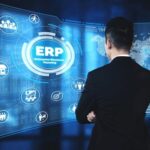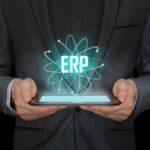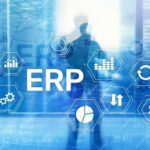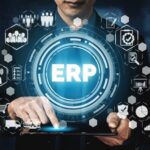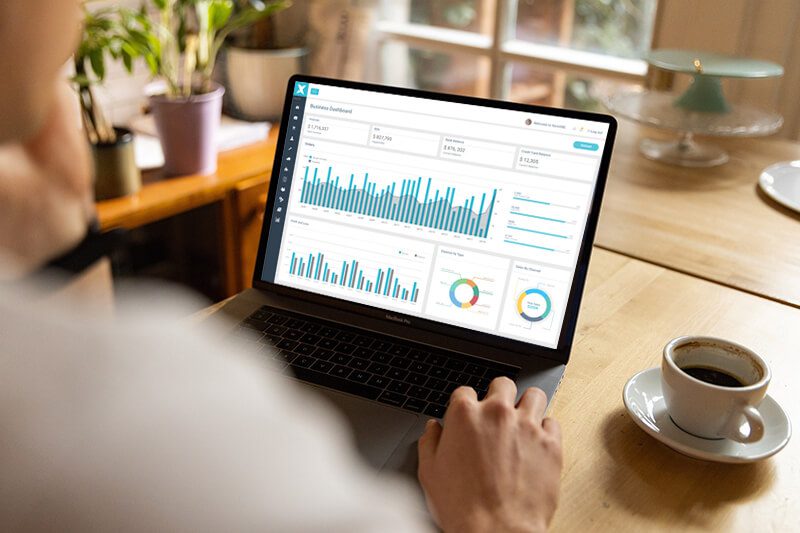
ERP software automates and controls key business processes for optimal performance. It organizes data between the business processes of a company, making a single source of truth and making things easier to do. It can integrate a company’s finances, supply chain, operations, commerce, reporting, manufacturing, and HR.
Most organizations have separate financial and operational systems, but isolated systems can’t help with growth. As companies grow, their systems should evolve. This article explains what ERP is and why it may help you operate a more agile and effective business.
Historical vs. Modern ERP Systems
ERP systems were once separate packages that didn’t integrate. To meet the unique needs of each company, each system needs expensive, complex, and specialized programming. This can delay or stop new technology or process optimization.
Modern ERP software combines all these procedures into one dynamic system. It has one platform for accounting, inventory, e-commerce, manufacturing, supply chain, human resources, and relationship management. It connects all your data so you can get better insights that help you improve the way your business works.
Modern ERP solutions offer flexible deployment, increased security and privacy, sustainability, and low-code customization. It gives your business and operations stability and resilience by giving you insights that let you plan for the future and come up with new ideas quickly.
Difference between ERP and Financials
Financials and ERP are not the same, despite being used interchangeably. ERP includes financial modules.
Financials encompass accounting, subledger accounting, accounting hub, payables and receivables, revenue management, billing, grants, cost management, project management, asset management, joint venture accounting, and collections. The IFRS, FASB, and GAAP reporting rules (HGB in Germany and PCG in France, for example) are met by the reporting and analysis features of financial software. For public firms, financial software must provide periodic financial statements for regulators like the US Securities and Exchange Commission (SEC) (with reports like the quarterly 10-Q and yearly 10-K) and ESMA. These financial reports employ narrative reporting. The CFO oversees finances.
ERP covers several corporate functions, including financials. ERP software can manage purchasing, inventory, production, maintenance, order management, project management, logistics, product lifecycle management, risk management, enterprise performance management (EPM), and human resources/human capital management.
ERP interfaces with front-office tools to create comprehensive client perspectives, including CRM. Cloud-based ERP software frequently includes IoT, blockchain, AI, machine learning, and digital assistants. These modern technologies augment many classic ERP activities and provide new potential for enhanced efficiencies, new services, and deeper insight. ERP systems are enterprise-wide, so their administration involves the CFO, CIO, COO, and other executives.
Cloud-based ERP applications include IoT, blockchain, AI, machine learning, and digital assistants.
How Cloud ERP Compares to On-premise ERP
On-premise and cloud ERP vary fundamentally. On-premise ERP systems are put on your company’s hardware and servers and are taken care of by IT. Cloud ERP, on the other hand, is a service. The ERP provider keeps the ERP software and data in the “cloud” of the Internet, which can be accessed through a web browser.
The sort of ERP deployment methodology you pick might affect your entire firm. Consider these aspects while deciding between on-premise and cloud-based ERP software.
Cost of Ownership
On-premise ERP solutions cost a lot of money upfront and on an ongoing basis for software, hardware, servers, and facilities. If your organization lacks a large or experienced IT workforce, you may need to train new employees. With on-premise solutions, your IT team has to put in a lot of time and money to maintain hardware, server rooms, and other things. When upgrading, IT must reinstall the ERP system across users’ PCs and re-implement customizations and integrations.
Initial costs for cloud-based ERP are lower since you just set up the program and access it online. The cloud ERP provider hosts and maintains your IT infrastructure, making sure the system works all the time and adding new features to the product without interrupting your changes. Your IT staff may be more interested in coming up with new ideas and growing the business than in maintaining and running systems on-site. Cloud ERP’s predictable, pay-as-you-go subscription model simplifies cash flow management and budgeting.
IT savings accumulate over time. Research indicates that cloud-based ERP can cost 50% less than on-premise ERP over four years for a 100-employee organization.
System Upgrades
On-site ERP software can be changed to fit your needs, but these changes are tied to your current deployment and are hard to put back into future versions. Your IT staff will have to start customizing from scratch as your ERP supplier delivers new upgrades and features. Many Organizations delay modernizing their on-site ERP software and instead use outdated technologies. Two-thirds of midsize companies use obsolete ERP software.
Cloud ERP solutions like Xorosoft are constantly updated by the supplier, so you’ll always have the newest version. Because the best cloud apps are built on a cloud platform, changes and integrations that have already been made move over without any extra work.
Performance and Availability
Cloud ERP outperforms on-premise options. The cloud software architecture is built for optimal network performance, which can improve application availability over on-site ERP systems. Cloud-based ERP delivers enhanced, adaptable performance. Cloud ERP automatically adapts and adds resources to manage a business boom. Xorosoft ERP promises 99.5% availability for its clients and has a 99.98% average uptime over the previous 12 months. A local IT department might not be able to tell management how long a system has been up and running.
Deployment
Cloud ERP implementations take 3-6 months, whereas on-premise solutions require 12 months. As your business grows, you may add more users to cloud-based ERP solutions. On-site ERP systems don’t offer the same flexibility; to give more staff access, you must purchase hardware.
Why is ERP important for my company?
After integrating your processes, systems, and data, you’ll get business intelligence, speed, and flexibility.
An ERP system can help your business in three ways:
1. Perform effectively.
AI-powered solutions increase decision-making and operational performance.
2. Increase the impact.
By linking processes and data, you’ll give your employees more information and freedom, which will help them act quickly and provide more value.
3. Enterprise agility
Many ERP solutions can be changed to fit your needs and grow with your business. This helps you get ready for unplanned events and changes in the business environment and figure out how to deal with them.
Which aspects of a company’s operations can be improved with the help of ERP?
An ERP system may cover many of your company’s core functions. This can help break down barriers between the front and back offices and adapt to changing business needs. Business functions include:
E-Commerce
An ERP system can offer a full omnichannel commerce solution that includes interactions in the back office, in stores, and online. Intelligent recommendations give customers a more personalized and smooth shopping experience while also improving staff efficiency, reducing fraud, automating AR processes, and growing their businesses.
Finance
ERP improves profitability and compliance. It provides dashboards and enhanced analytics to provide a real-time snapshot of your finances. It will automate jobs that people do over and over again to cut down on the amount of data entry that people have to do and track compliance with regulations.
HR
Modern solutions simplify staff management processes, including payroll, recruiting, and more. You’ll be able to keep employees, find new ones, and give them more power. You’ll also be able to track employee performance and spot HR issues before they happen.
Manufacturing
This ERP technology makes it easier for companies to talk to each other, automates daily tasks through process automation, and lets manufacturers meet customer requests and manage resources using real-time data. Project, cost, and production planning are simplified.
Procurement and Supply Chain
By automating MRP tasks like data entry and inventory tracking in the warehouse, your company will save time and money. Modern supply chain systems use dashboards, business data, and Internet of Things (IoT) technologies to keep track of inventory and communicate with your ERP system.
Three signs you need an ERP System now
If you’re having trouble with your existing systems and are reading this, you might be considering if now is the perfect moment to make a switch. Here is a list of red flags that show you need to get new ERP software:
The fundamentals are stopping you from moving ahead:
You may have been able to get by with only the most fundamental of tools, but if the software you’re using now is restricting your ability to grow in new markets or on a global basis, it might be time to invest in an improved enterprise resource planning (ERP) system that is adaptable enough to accommodate expansion.
You have to deal with several kinds of systems:
Because technology has gotten better, you have found that the different systems you use don’t work well together. Your company’s new accounting software might not work with its old HR management system, and you’re tired of wasting time and money trying to find a workaround.
You are unable to live up to the standards set by your customers:
If both your employees and customers are always on the go but your current system is unable to keep up with their demands, it’s time to upgrade to a solution that can accommodate everyone. If you invest in meeting the expectations of your consumers and providing your employees with the skills they need to be successful, you can keep your business ahead of the competition.
Advice: If you or your team are asking for a new system and there is opposition to an ERP change, plan a demo with Xorosoft so that everyone can see what options are available. This will allow everyone to make an informed decision. When everyone has the sense that they are included in the decision-making process, the implementation of the plan will be much simpler.
Three ERP implementation hurdles.
Some companies are hesitant to embrace ERP despite the alternatives. Many reasons exist, yet every problem does have a solution.
ERP selection
You don’t need a flawless software remedy. Most of your company’s operations should be under one system so everyone can access the same information.
Choosing the appropriate technology partner is essential. Select a partner that can actually “do” stuff. Most third-party partners can only configure different settings but can’t change the application based on your business logic.
ERP expense
All-or-nothing solutions aren’t necessary. Software modules can be purchased separately. This will help your team adopt ERP slowly and avoid a big software upgrade before they know if the extra features will be worth it. Any ERP package you pick should fit with what you’re using currently and incorporate growth features. You might want to add business intelligence to your software if it handles finances, the supply chain, and manufacturing.
Existing software integration
Make sure your software has a current architecture that allows easy integration with other systems. Most ERP systems, including Xorosoft ERP, now have built-in connections to E-Commerce, Fulfillment, and EDI platforms, so you don’t have to start from scratch. Avoid third-party connections and use native integrations if possible.
Misconception: Many ERP implementations fail.
It’s why many C-level executives dread ERP updates or replacements. After looking at 300 manufacturers, Mint Jutras found that most deployments are successful or very effective. When firms dedicate the right resources to the ERP selection and implementation procedures, they will end up with a more efficient, less wasteful solution that will swiftly achieve a complete ROI.
Failed implementations may wreck careers. Companies that fail at implementation have four similar themes. Best practices help limit these hazards.
1. No full-time project manager
In some failed implementations, the IT director or manager manages the project. This delays and/or overbudgets projects. Implementation projects and everyday activities might be difficult to balance, causing both to suffer.
Forward-thinking organizations will have a project manager/project management office (PMO) with professionals to reduce risk throughout the implementation lifecycle, mentor project managers, and make sure each follows the specified implementation approach.
2. Competence problems
SMBs fail by not bringing in subject-matter experts to analyse business processes. These resources lack end-to-end organisation knowledge and industry experience to give implementation instructions.
Companies that don’t do a thorough business process analysis or scoping early in the project can suffer schedule delays and expense overruns. Selecting the right partner who understands your industry and has the necessary business knowledge is the key.
3. Inadequate testing
Successful ERP testing is crucial. It shows if business processes and systems are operating together. Companies generally focus on single transaction phases instead of end-to-end procedures during testing. One stage is authenticating a sale order’s pricing. Ensure the order can be assigned, selected, packed, and sent as planned.
Testing requires teamwork. Everyone plays a part. When creating testing strategies, examine your whole business to avoid forgetting essential procedures.
4. Management views ERP as an IT project
Viewing ERP implementation as an IT project might restrict its effectiveness. When all of a business’s departments are involved in the implementation, it’s important to have subject matter experts on hand at all times.
Executive buy-in and support are important to preventing implementation failure.
8 stages of ERP implementation life cycle
Step 1: Selection
Every business’s demands vary. First and foremost, choose the correct ERP software for your firm. With so many alternatives, it might be difficult to pick the best one for your organization. In this stage, non-required ERP modules are deleted.
Step 2: Planning
Any project must be well-planned to avoid surprises during implementation. Planning is important for a successful ERP implementation, from choosing the right resources to figuring out who will do what.
Step 3: Analyze GAP
GAP analysis is another important part of installing ERP. It compares the current system to where it will be in the future. So you can simply identify your ERP’s essential processes.
Step 4: Reengineering and Customisation
Re-engineering is used to make a process more effective and valuable based on planning and gap analysis.
Step 5: Training
Since there’s a new system, staff will need training to use it smoothly.
Step 6: Testing
Another important ERP implementation stage. It’s used to identify and fix issues before the application process.
Step 7: ERP implementation.
Once all the data is collected, analysed, and transformed, the new implementation is done and the old system is retired.
Step 8: Hypercare and Support
ERP support is the final phase. Now that the new system is in place, your ERP Vendor should give a adequate support until your team is fully adapted to the new ERP System
Get started with Xorosoft ERP
Organizations have had a hard time balancing the high cost and complexity of traditional ERP with the need for custom features and flexibility. Learn how Xorosoft ERP Cloud connects teams, unifies data, and provides insightful information to help you make the best business choices. Your company can outrun change with cloud-based ERP.
SaaS software is updated with the newest features, capabilities, and best practices. Xorosoft’s cloud ERP updates monthly. This means users get AI, digital assistants, machine learning, blockchain, augmented reality, and IoT on a regular cadence.
As ERP software advances, organizations may improve business practices with new technology. They can automate manual tasks like account reconciliation. Users obtain a real-time view of enterprise business activity in the front office, warehouses, and factories. This information is then available on employees’ cell phones and tablets.
A modern ERP cloud includes mobile, social, analytics, and developing technologies. Less won’t advance a company.
